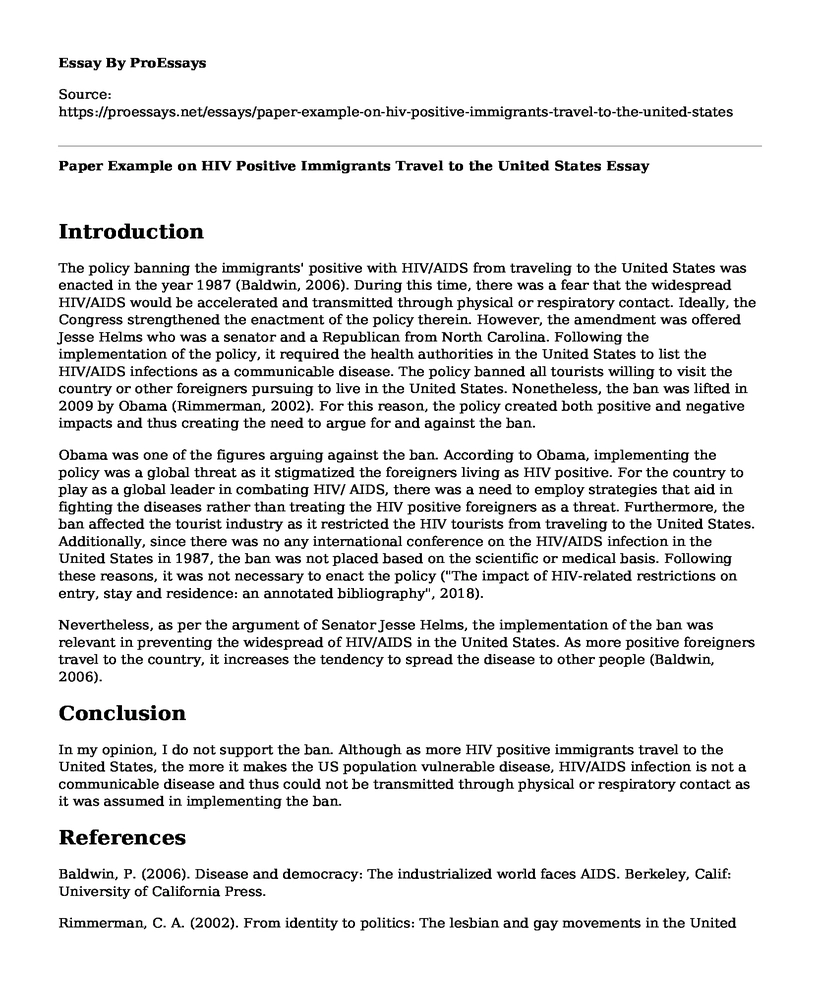Introduction
The policy banning the immigrants' positive with HIV/AIDS from traveling to the United States was enacted in the year 1987 (Baldwin, 2006). During this time, there was a fear that the widespread HIV/AIDS would be accelerated and transmitted through physical or respiratory contact. Ideally, the Congress strengthened the enactment of the policy therein. However, the amendment was offered Jesse Helms who was a senator and a Republican from North Carolina. Following the implementation of the policy, it required the health authorities in the United States to list the HIV/AIDS infections as a communicable disease. The policy banned all tourists willing to visit the country or other foreigners pursuing to live in the United States. Nonetheless, the ban was lifted in 2009 by Obama (Rimmerman, 2002). For this reason, the policy created both positive and negative impacts and thus creating the need to argue for and against the ban.
Obama was one of the figures arguing against the ban. According to Obama, implementing the policy was a global threat as it stigmatized the foreigners living as HIV positive. For the country to play as a global leader in combating HIV/ AIDS, there was a need to employ strategies that aid in fighting the diseases rather than treating the HIV positive foreigners as a threat. Furthermore, the ban affected the tourist industry as it restricted the HIV tourists from traveling to the United States. Additionally, since there was no any international conference on the HIV/AIDS infection in the United States in 1987, the ban was not placed based on the scientific or medical basis. Following these reasons, it was not necessary to enact the policy ("The impact of HIV-related restrictions on entry, stay and residence: an annotated bibliography", 2018).
Nevertheless, as per the argument of Senator Jesse Helms, the implementation of the ban was relevant in preventing the widespread of HIV/AIDS in the United States. As more positive foreigners travel to the country, it increases the tendency to spread the disease to other people (Baldwin, 2006).
Conclusion
In my opinion, I do not support the ban. Although as more HIV positive immigrants travel to the United States, the more it makes the US population vulnerable disease, HIV/AIDS infection is not a communicable disease and thus could not be transmitted through physical or respiratory contact as it was assumed in implementing the ban.
References
Baldwin, P. (2006). Disease and democracy: The industrialized world faces AIDS. Berkeley, Calif: University of California Press.
Rimmerman, C. A. (2002). From identity to politics: The lesbian and gay movements in the United States. Philadelphia: Temple University Press.
The impact of HIV-related restrictions on entry, stay and residence: an annotated bibliography. (2018). Retrieved from http://www.unaids.org/sites/default/files/media_asset/jc1729_bibliography_en_0.pdf
Cite this page
Paper Example on HIV Positive Immigrants Travel to the United States. (2022, Jun 29). Retrieved from https://proessays.net/essays/paper-example-on-hiv-positive-immigrants-travel-to-the-united-states
If you are the original author of this essay and no longer wish to have it published on the ProEssays website, please click below to request its removal:
- Licensed Practicing Nursing Career Plan Example
- Ectopic Pregnancy: Effects, Risks, & Prevention - Research Paper
- Research Paper on Latin America: A Look at 21 Countries
- Eat Healthy to Prevent Type II Diabetes: Diet's Role in Diabetes Prevention - Research Paper
- Essay on COVID-19: Global Pandemic Spreads Fast and is Highly Contagious
- Free Report Example on Rehab Services: Peterson Health Care's Mission
- Article Review Example on Notes from Under the Dome: Pro-Life Stance by George McKenna







